Nebulae
IC 434 The Horsehead Nebulae in Orion - Jan. 26, 2022
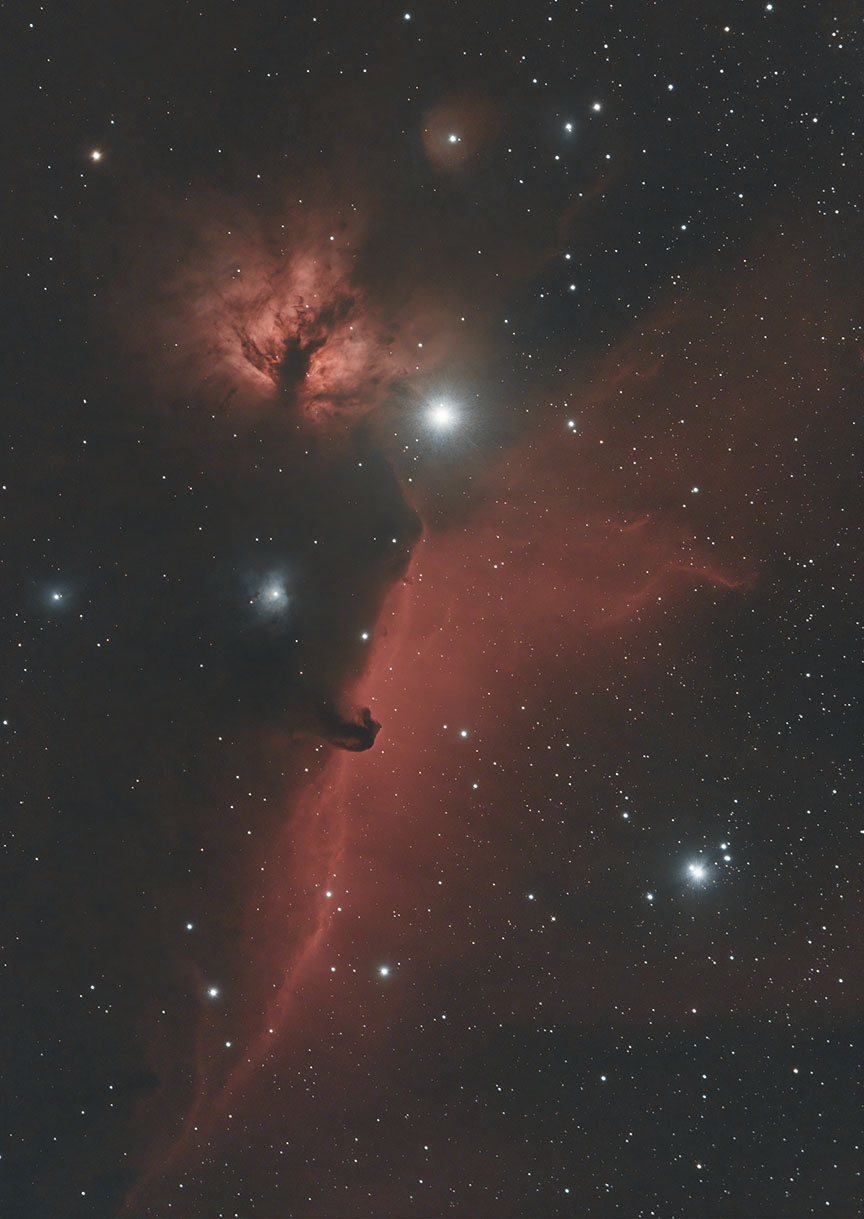
The Horsehead (IC 434) and Flame (NGC 2024) Nebulae in Orion in one shot color narrowband.
For a larger view in a new window, click on the image.
Details:
Location: Front yard Cary, NC
Camera: ZWO ASI294MC-Pro
Exposure: 32x120s subs at gain 150
Filter: Optolong L-eNhance
Scope: TeleVue Genesis 4" f/5
Mount: iOptron GEM-45
Guider: 60mm Orion finder/guider with ASI120mm-s camera
Capture software: APT
Guiding software: PHD2
Calibration frames: 13 flats and 13 darks
Processing software: PixInsight, Photoshop, and Topaz Denoise AI
Weather conditions: Clear and cold with temps in the mid-20s.
Notes:
The image is slightly cropped at the top.
Back to Mark's Astrophotography Home
M42, M43, and Running Man Nebulae in Orion - Jan. 26, 2022
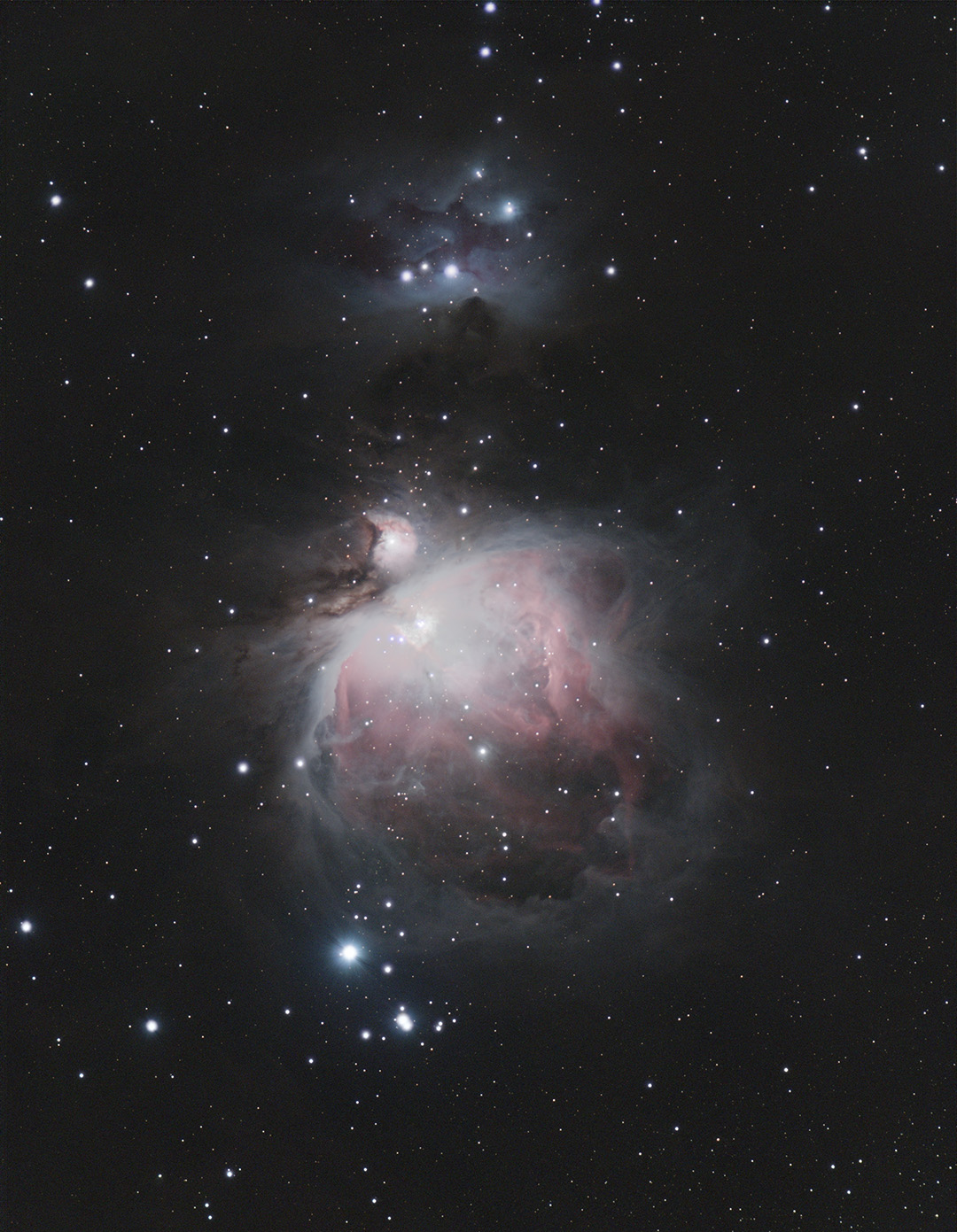
The Great Orion Nebula area in broadband high dynamic range.
The Running Man Nebula (NGC 1977) is at the top,
in the upper center M43 is the round bright nebula with a star in it's center,
and M42 fills up the center to the bottom of the image.
High dynamic range techniques in Photoshop allow the Trapezium star cluster to show through
the brightest areas of M42 without being blown-out.
For a larger view in a new window, click on the image.
Details:
Location: Front yard Cary, NC
Camera: ZWO ASI294MC-Pro
Exposure: 15x5s, 30x30s, and 15x60s subs at gain 150
Filter: none
Scope: TeleVue Genesis 4" f/5
Mount: iOptron GEM-45
Guider: 60mm Orion finder/guider with ASI120mm-s camera
Capture software: APT
Guiding software: PHD2
Calibration frames: 13 flats and 13 darks for each exposure group
Processing software: PixInsight and Photoshop
Weather conditions: Clear and cold with temps in the mid-20s.
Notes:
I combined the 30x30s and 15x60s subs together to make a master "bright" M42 image.
I spent hours experimenting with various ways to control the bloating of the bright
stars in the photo.
I finally settled on a soft stretch from PI,
then in Photoshop I did a reduce blue halo from Carboni's tools,
back in PI I did a EZ star reduction using morphological transform.
I took the resulting tiff file back into Photoshop and combined it with the original halo reduced image
and a mask to only reduce the brightest stars.
I wanted to be able to see the Trapezium stars so
I used the 15x5s image with a mask and combined it with the bright M42
to show the core without blowing it out.
The original sub-exposures show lots of geostationary satellites that were averaged out during integration.
The image displayed has been cropped some at the bottom.
Back to Mark's Astrophotography Home
LDN 1165 with other dark nebulae in Cepheus - Sept. 26, 2021
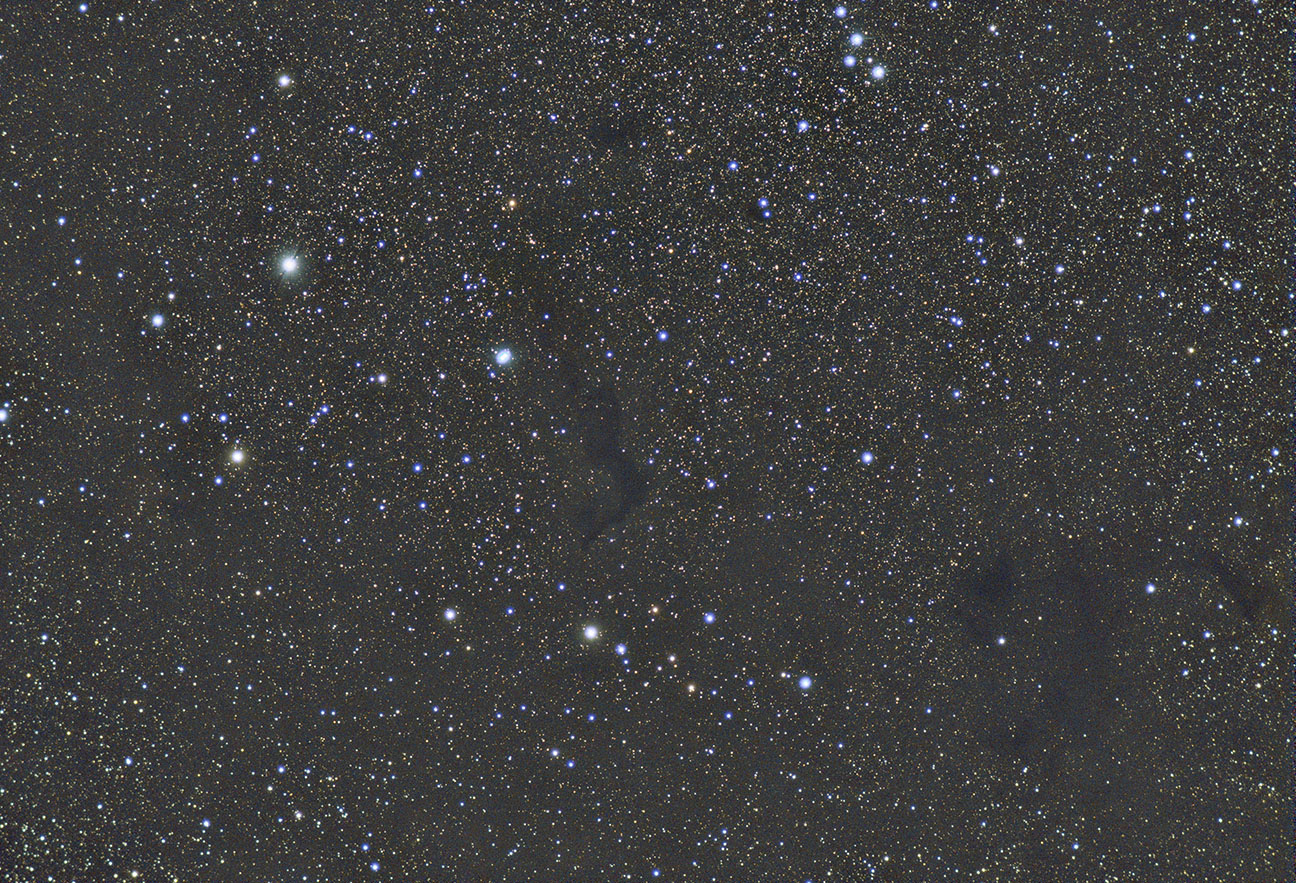
Dark nebula LDN 1165 (center) was my main target, but I was surprised to get the
other dark nebula in the bottom right part of the frame.
I could not find an id on it.
This view is un-cropped.
This photo was experiment to see if I could get dark nebulae unfiltered from
my suburban home location.
Gradients were not as bad as expected, so it seemed to work reasonably well.
For a larger view in a new window, click on the image.
Details:
Location: Front yard Cary, NC
Camera: ASI294MC-pro gain:150
Exposures: 41 x 90s
Filter: none
Scope: TeleVue Genesis 4" f/5 refractor
Mount: iOptron GEM-45
Guider: Orion finder/guider with ASI120mm-s camera
Capture software: APT
Guiding software: PHD2
Calibration frames: 13 x 90s darks, 13 x 2s flat darks, and 13 x 2s flats
Processing software: Pixinsight and Photoshop
Notes:
Pixinsight was used for data reduction, align, stack, ABE, Photometric CC,
and convert to tiff.
Photoshop was used for the the resize and convert to jpg.
GradientXTerminater was used to clear some gradients.
Back to Mark's Astrophotography Home
NGC 7380 The Wizard Nebula in Cepheus - Sept. 10, 2021
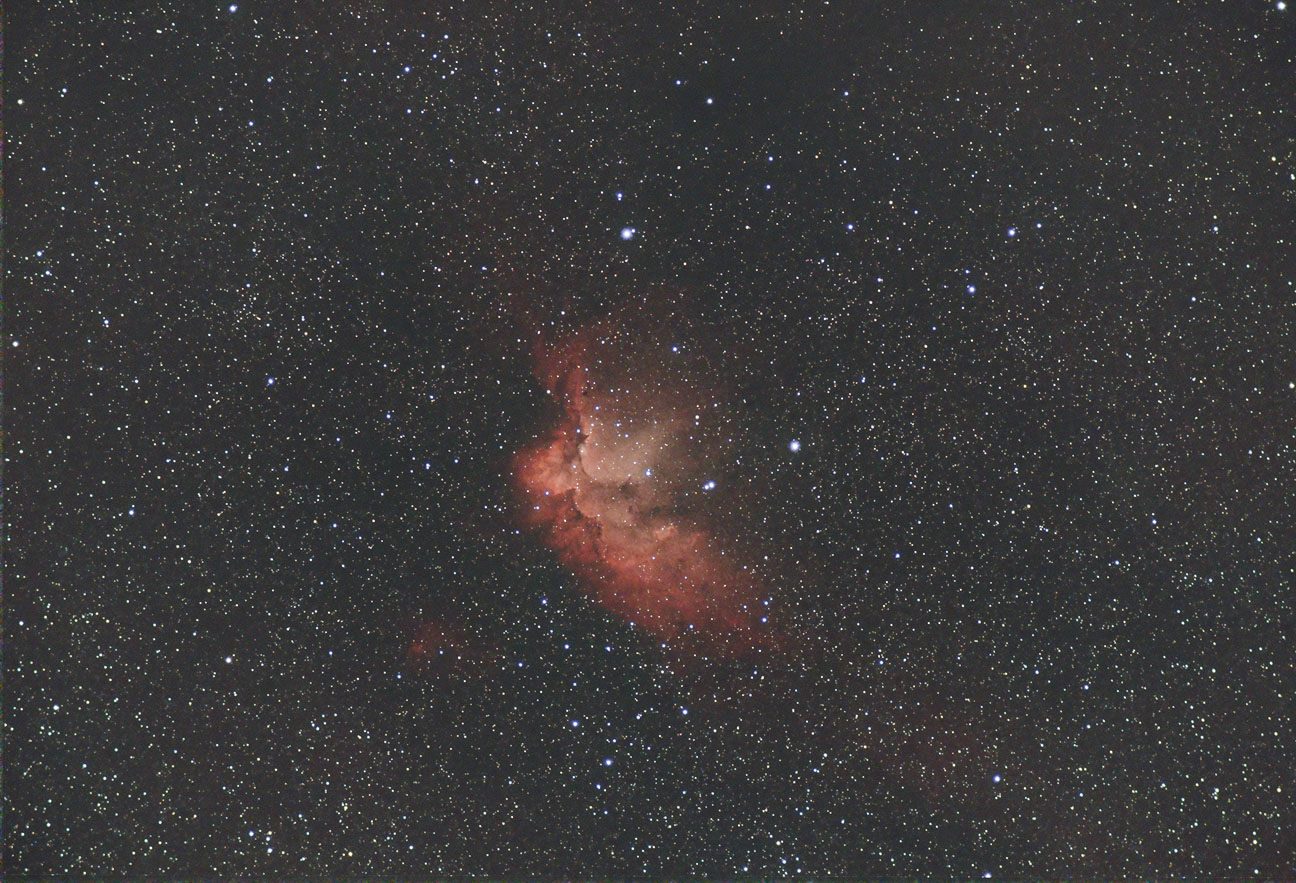
The Wizard Nebula in narrowband and broadband.
The stars were removed from the narrowband image and
then combined with the unfiltered image for natural star colors.
For a larger view in a new window, click on the image.
Details:
Location: Front yard Cary, NC
Camera: ASI294MC-pro gain:150
Exposures: 21 x 180s narrowband and 15 x 15s unfiltered
Filter: Optolong L-eNhance
Scope: TeleVue Genesis 4" f/5 refractor
Mount: iOptron GEM-45
Guider: Orion finder/guider with ASI120mm-s camera
Capture software: APT
Guiding software: PHD2
Calibration frames: 13x15s darks, 13 x 180s darks,
13 x 2s flats, 13 x 4s flats, and matching flat darks
Processing software: Pixinsight and Photoshop
Notes:
Pixinsight was used for data reduction, align, stack, ABE, Photometric CC,
and convert to tiff.
Photoshop was used for the combine of the broadband and narrowband data and
finally the resize and convert to jpg.
Back to Mark's Astrophotography Home
Barnard 72 The Snake Nebula - Sept. 3, 2021
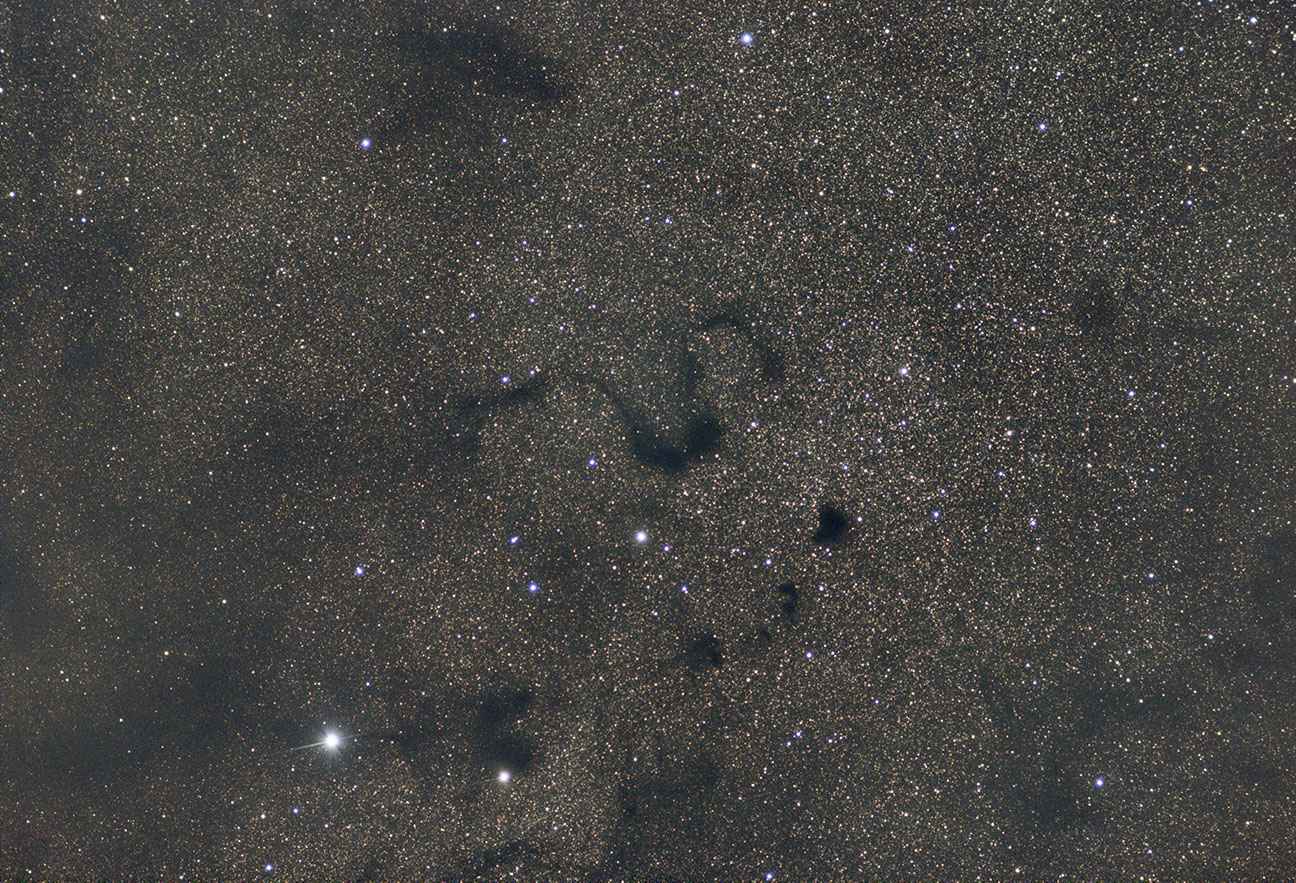
The Snake Nebula (Barnard 72) in Southeast Ophiuchus near the Sagittarius and Scorpius border.
Lots of other dark nebulae are also present in this 1.5 by 2 degree field.
The photo is uncropped.
This is one hour of integration time.
No filters were used.
It was a nice cool late summer evening but the skies seemed a bit hazy.
For a larger view in a new window, click on the image.
Details:
Location: Bigwoods site at Jordan Lake, NC
Camera: ASI294MC-pro gain:150
Exposures: 40 x 90 sec
Filter: none
Scope: TeleVue Genesis 4" f/5 refractor
Mount: iOptron GEM-45
Guider: Orion finder/guider with ASI120mm-s camera
Capture software: APT
Guiding software: PHD2
Calibration frames: 13x90s darks, 13x2s flats, and 13x2s flat darks
Processing software: Pixinsight and Photoshop
Notes:
Pixinsight was used for data reduction, align, stack, ABE, Photometric CC,
and convert to tiff.
Photoshop was used for resize and convert to jpg.
Back to Mark's Astrophotography Home
M16 the Eagle Nebula in Serpens - July 3, 2021
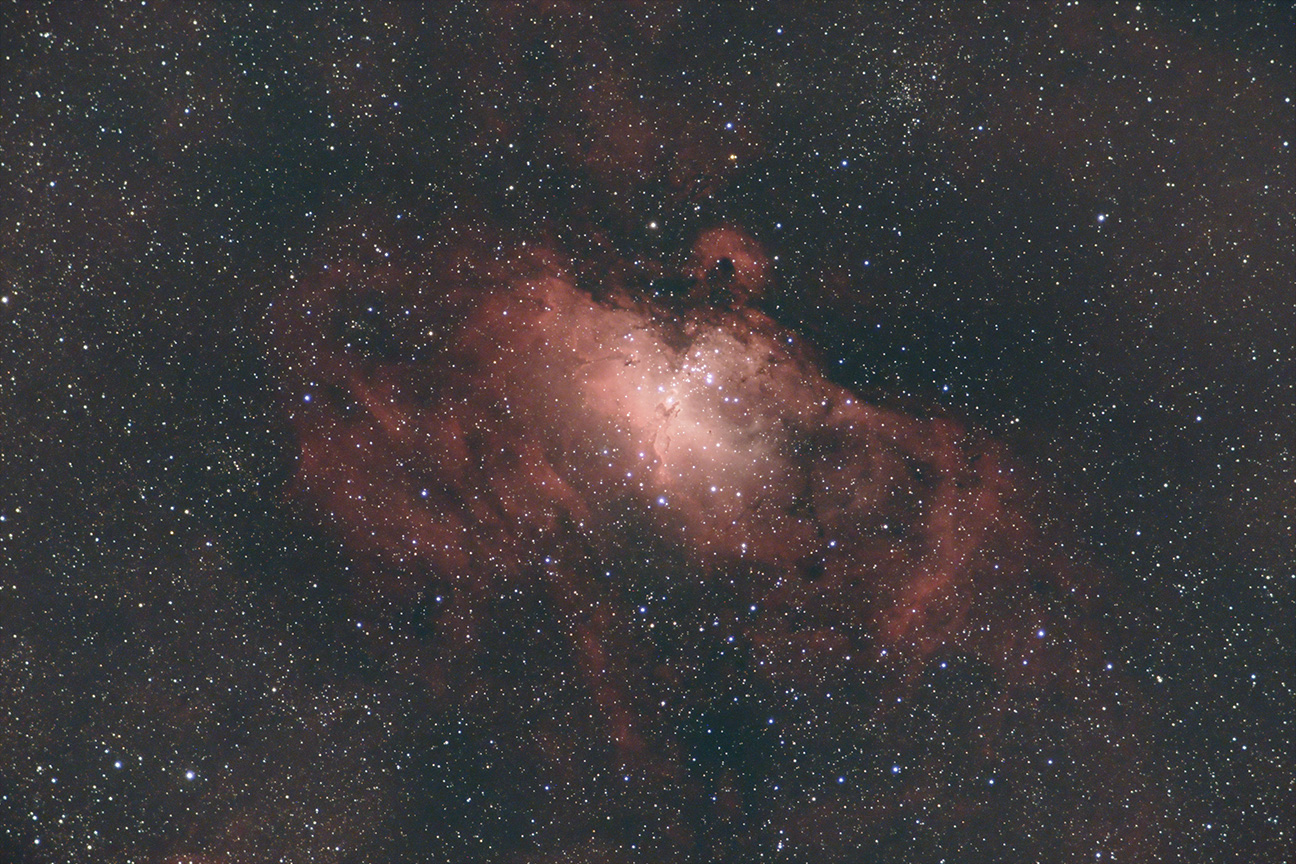
M16 The Eagle Nebula in broadband and narrowband. Click on the image for a larger view.

Crop of the Pillars of Creation inside M16. Narrowband data only shown at full scale.
Location: Cary, NC in my front yard
Camera: ASI294MC-pro gain:150
Exposures: narrowband 25 x 180 sec
Exposures: unfiltered 25 x 15 sec
Filter: Optolong L-eNhance
Scope: TeleVue Genesis refractor 4" f/5
Mount: iOptron GEM-45
Guider: Orion 60mm finder-guider
Capture software: APT
Guiding software: PHD2
Processing software: Pixinsight and Photoshop
Notes:
The top image of M16 is made from two different image sets.
The first set was 25 x 3 minute subexposures using the Optolong L-eNhance narrowband filter
to capture the Eagle Nebula.
The second set of exposures was 25 x 15 seconds unfiltered to capture
natural star colors.
Starnet++ was used to remove the stars from the narrowband image.
The two sets of data were brought into Photoshop as two separate layers then blended together.
Pixinsight was used for data reduction, crop, align, stack, ABE, scnr, Photometric CC,
EZ noise reduction, and convert to tiff.
Back to Mark's Astrophotography Home
Rho Ophiuchus Area from the Suburbs - June 16, 2021

Rho Ophiuchus dark nebula, Antares, and globular clusters M4 (bottom right)
and NGC6144 (lower center) on the Scorpius and Ophiuchus border.
These objects spend less than an hour above my treeline so data aquisition
is hard this time of year with cloudy weather making things worse.
The photo was cropped on the top and bottom. North is up.
I attempted this area back in 2015 with a DSLR and 135mm lens from a dark site -
click here to see that photo.
Location: Cary, NC in my front yard
Camera: ASI294MC-pro gain:150
Exposures: 37 x 60 sec
Filter: Astronomik CLS
Scope: Nikkor 180 mm lens at f/2.8
Mount: iOptron GEM-45
Guider: none
Capture software: APT
Guiding software: none
Processing software: Pixinsight and Photoshop
Notes:
This started out as an experiment to see if it was even possible to get anything
from my yard. It worked out better than I expected but not like a dark site.
Pixinsight was used for data reduction, crop, align, stack, DBE, Photometric CC,
EZ noise reduction, SCNR, and convert to tiff.
Photoshop CC was for final crop, resize, and convert to jpg.
Back to Mark's Astrophotography Home
Christmas Tree Cluster/Cone Nebula/Hubble's Variable Nebula Mar. 11, 2021
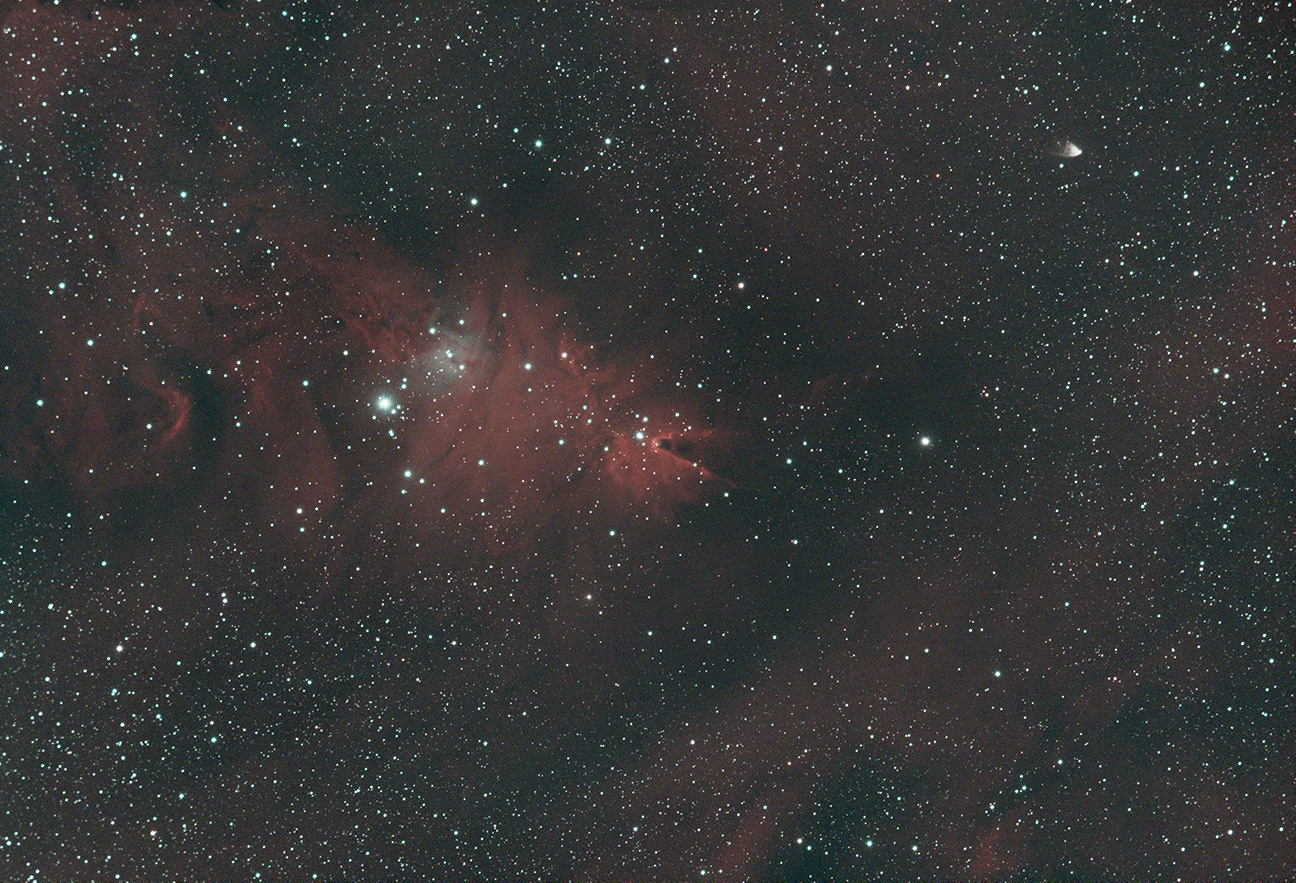
The main subject of the photo is NGC2264 - the Christmas Tree Cluster/Cone Nebula in Monoceros.
Also in the photo at top right is NGC2261 - Hubble's Variable Nebula.
The photo was taken from my front yard in Cary, NC.
The night was mild and very breezy with high clouds moving through.
30 x 3 minute sub-exposures (1.5 hours) at gain 150 were used to create the final photo.
North is to the left.
Data was captured with an ASI294mc-pro one shot color camera
with an Optolong L-eNhance filter.
The scope and mount used was my 4" f/5 TeleVue Genesis refractor
on an iOptron GEM-45 mount.
I used a 60 mm finder/guider with an attached ASI120mm to guide.
The view shown if the full frame of the ASI294 (not cropped).
APT software was used to capture the images and PHD2 was used to guide.
All data was reduced, integrated, and minimally processed (ABE and color correction) with PixInsight.
The tiff image from PI was taken to Photoshop CC for curves and convert to jpg.
For a larger view in a new window, click on the image.
Back to Mark's Astrophotography Home
NGC 2359 Thor's Helmet Feb. 3, 2021 and Mar. 3, 2021
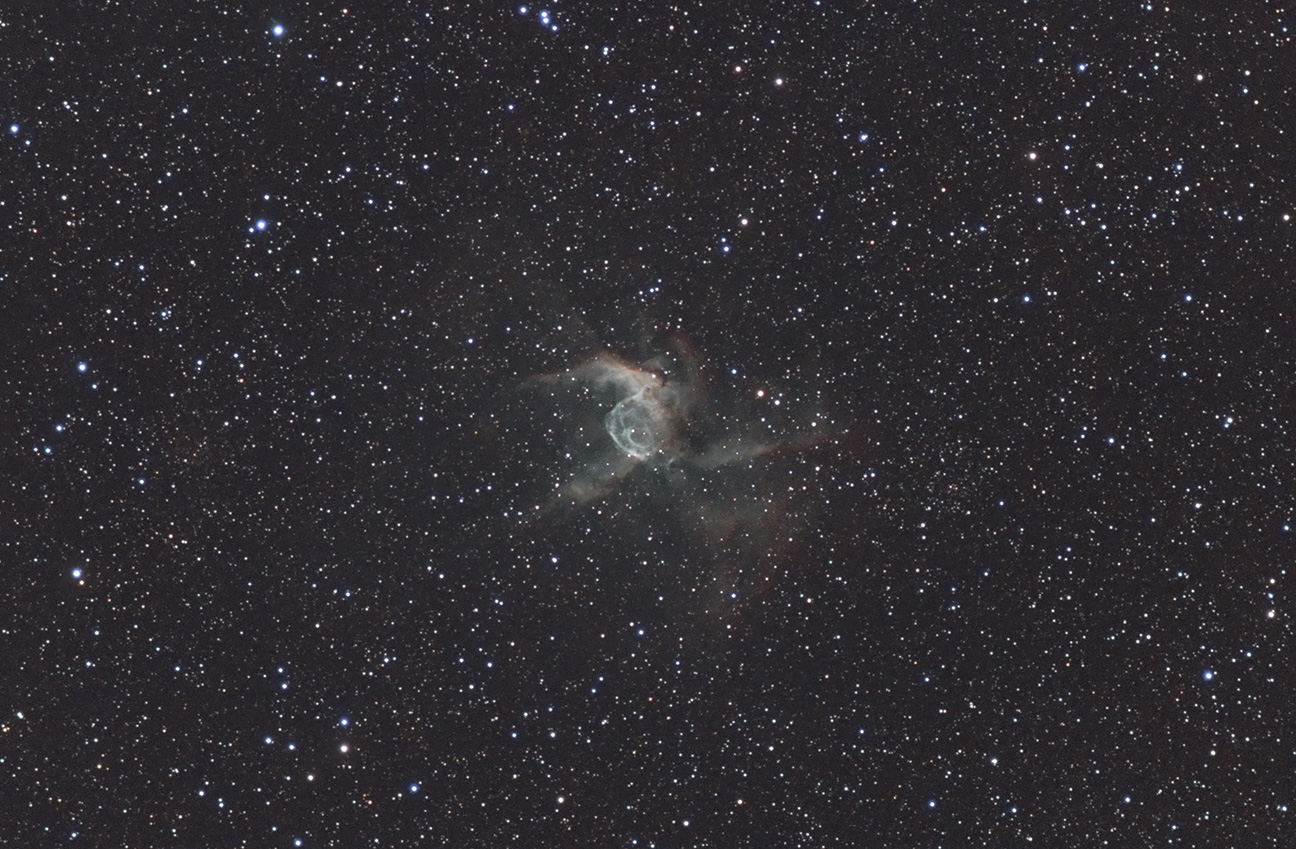
Thor's Helmet is a faint emission nebula located in Canis Major.
It resembles the mythological Norse god's headwear.
The image above is a combination of broadband images with a LP filter
and narrowband images taen with a narrowband filter.
22 x 2 min broadband subframes at gain 120 were taken on Feb. 3 using an Optolong L-Pro filter.
31 x 2 min narrowband subframes at gain 150 were taken on Mar. 3 using an Optolong L-eNhance filter.
The images were taken in my front yard with an ASI294mc-pro one shot color camera.
All images were taken through my 4" f/5 TeleVue Genesis refractor on an iOptron Gem-45 mount.
The shots were guided using an Orion 60mm finder/guider and an ASI120mm camera.
APT software was used to capture the images.
PHD2 was used to guide.
All data was reduced, integrated, and initially processed with PixInsight.
Starnet++ was used to remove the stars from the narrowband combination.
A TIFF file of the broadband combination and another of the starless narrowband combination were taken to Photoshop
where the data was combined as two layers.
Additionally, PS curves, levels, noise reduction, cropping, and convert to jpg were done.
For a larger view in a new window, click on the image.
Back to Mark's Astrophotography Home
NGC 1909 (aka IC 2118) Feb. 19, 2017 and Feb. 3, 2021
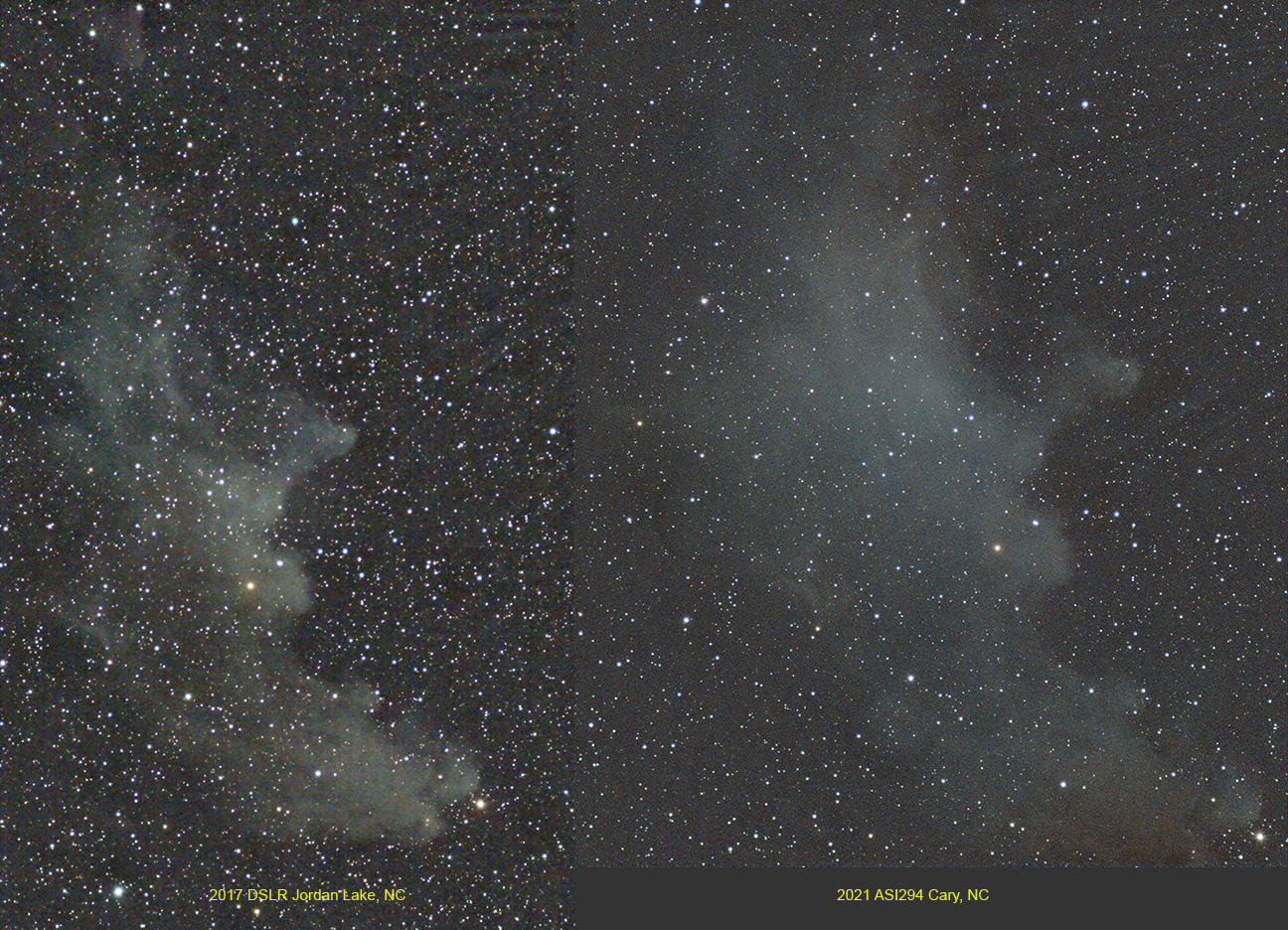
Displayed above are two views of the Witch Head Nebula taken four years apart.
The Witch Head Nebula is a reflection nebula in Eridinus very near the bright star Rigel in Orion.
The image is rotated so that South is at the top.
Both photos were taken through my TeleVue Genesis 4" f/5 refractor.
Single 3 minute subs show no nebula at all which makes
framing the Witch Head a real challenge.
The object fills the entire frame of both the DSLR and the ASI cameras.
The version on the left was taken at our semi-dark Bigwoods site at Jordan Lake with an old
astro-modified Canon XTi DSLR.
The image was made up from 23 x 2 minute exposures at ISO 1600.
The version on the right was taken in my front yard with an ASI294mc-pro and Optolong L-Pro filter.
It was made from 20 x 3min exposures at gain 150.
I have been on a quest since 2006 to try and get a decent photo of this faint object.
I still have a way to go!
I have a 2006 version (not shown here) that I took with my SBIG ST-402 and color filter wheel.
That effort left a lot to be desired mainly because the field of view was way too small.
Initially the 2017 DSLR version did not turn out well until I decided to reprocess
the original data with PixInsight in 2021.
It was a big improvement over my attempts using the ImagesPlus software.
With PI, I finally had a version that I was at least satisfied with how it looked
except for the bad centering.
It is the version shown above.
I decided in Feb. 2021 to see if it was even possible to image this object from my suburban
Cary front yard with all the LED street lights.
I put the L-Pro filter into the imaging train of my scope and camera and gave it a try.
Upon seeing the sub-frame images coming in to APT after each was taken, I could see nothing at all!
Only after stacking the data In PI did I realize I had anything at all to work with.
With some manipulation in PI and Photoshop it is almost comparible to the 2017 version.
Like the DSLR version, the centering was off.
I will probably try this object one again from home with longer exposure times with the ASI294
and maybe using a telephoto lens and see how that comes out.
For a larger view in a new window, click on the image.
Back to the top of the page
Back to Mark's Astrophotography Home
M78, NGC 2071, and Barnard's Loop in Orion - Feb. 3, 2021
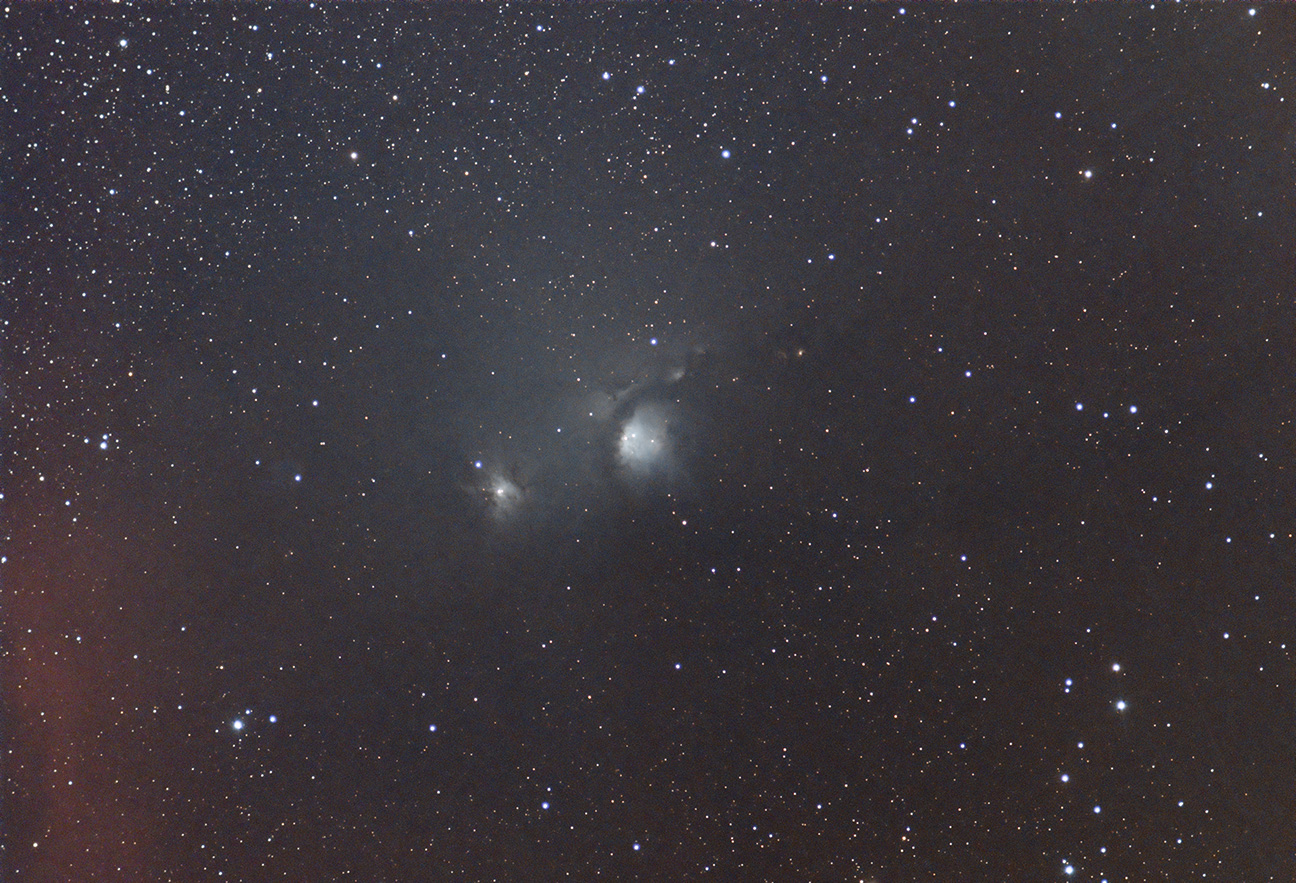
M78 (larger white nebula center), NGC 2071 (smaller nebula left of M78),
and part of Barnard's Loop (red nebula bottom left) taken from my front yard in Cary, NC.
North is left.
This image is made from 16 x 2 minute sub-exposures using my ASI294MC-Pro camera
at the prime focus of my TeleVue Genesis 4" f/5 refractor.
The camera gain was set to 150 and an Optolong L-Pro light pollution filter was used.
I used my iOptron GEM-45 mount for tracking.
Guiding was done with an ASI120mm camera attached to an Orion 60mm finder/guider.
APT was used to capture the images.
PixInsight was used to reduce and combine the individual frames.
Photoshop CC was used for curves and converting to jpg.
The image is the full ASI294 frame (not cropped).
The night was clear and cold with temps around 30 degrees F.
For a larger view in a new window, click on the image.
Back to the top of the page
Back to Mark's Astrophotography Home
NGC 1499 The California Nebula in Perseus - Dec. 14, 2020
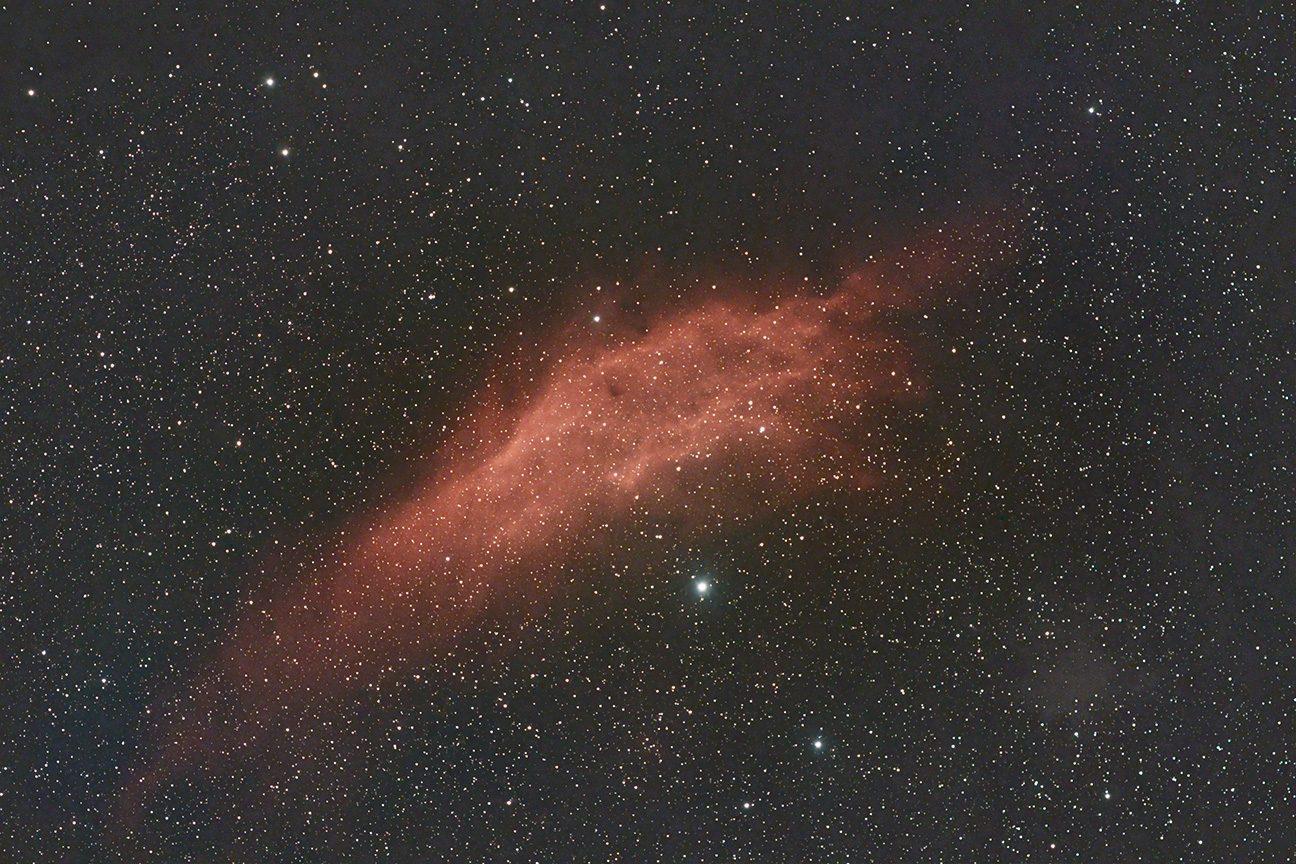
This is a wide angle shot of the California Nebula.
Twelve full moons would fit across the diagonal of the photo.
I was very pleased to be able to capture dark grey dust cloud
at the bottom right of the image especially with all the Christmas lights in my neighborhood.
Most images these days of the California Nebula are taken in narrowband,
but this is a broadband image.
This image was taken when the object was very high in the sky to help minimize
all the light pollution in my Cary, NC neighborhood.
I used my ASI294MC color camera at gain 150 attached to my Nikkor 180mm ED lens at f/2.8.
30 x 120s light frames, 11 x 120s dark frames, and 11 x 1s flat frames
were used to create this photo.
An Astronomik CLS filter was used to keep the light pollution down.
The lens and camera were mounted on an iOptron GEM-45 mount.
The shots were tracked but unguided.
I used APT to capture the images.
PixInsight was used to reduce and combine the individual frames.
Some star reduction in PI was used to tame down the overwhelming number of stars.
Photoshop CC was used for final gradient removal and levels changes before converting to jpg.
For a larger view in a new window, click on the image.
Back to the top of the page
Back to Mark's Astrophotography Home
Sh2-157 Lobster Claw Nebula in Cassiopeia - Oct. 6, 2020

This is a narrow band image of the Lobster Claw Nebula in Cass.
It also includes the small open cluster NGC7510 in the upper right.
At extreme upper left is a small portion of the Bubble Nebula complex.
This image was made from 18 x 3 minute exposures with an Optolong L-eNhance
narrow-band filter with an 85% illuminated moon up.
Poor sky conditions including high clouds forced me to discard 4 sub-exposutes.
The image was recorded from my front yard using an ASI294mc-pro one-shot color camera.
I used my Genesis 4" f/5 refractor telescope mounted on a iOptron GEM-45 equatorial mount.
An Orion 60mm finder/guider was used with an ASI120mm to guide with PHD.
The data was captured with APT. It was reduced, combined, and initially
processed with PixInsight.
I also tried for the first time the PixInsight EZ noise reduction and EZ star size reduction.
Photoshop CC was used for final curves and conversion from tiff to jpg.
For a larger view in a new window, click on the image.
Back to the top of the page
Back to Mark's Astrophotography Home
M52 area in Cassiopeia - Sept. 20, 2020
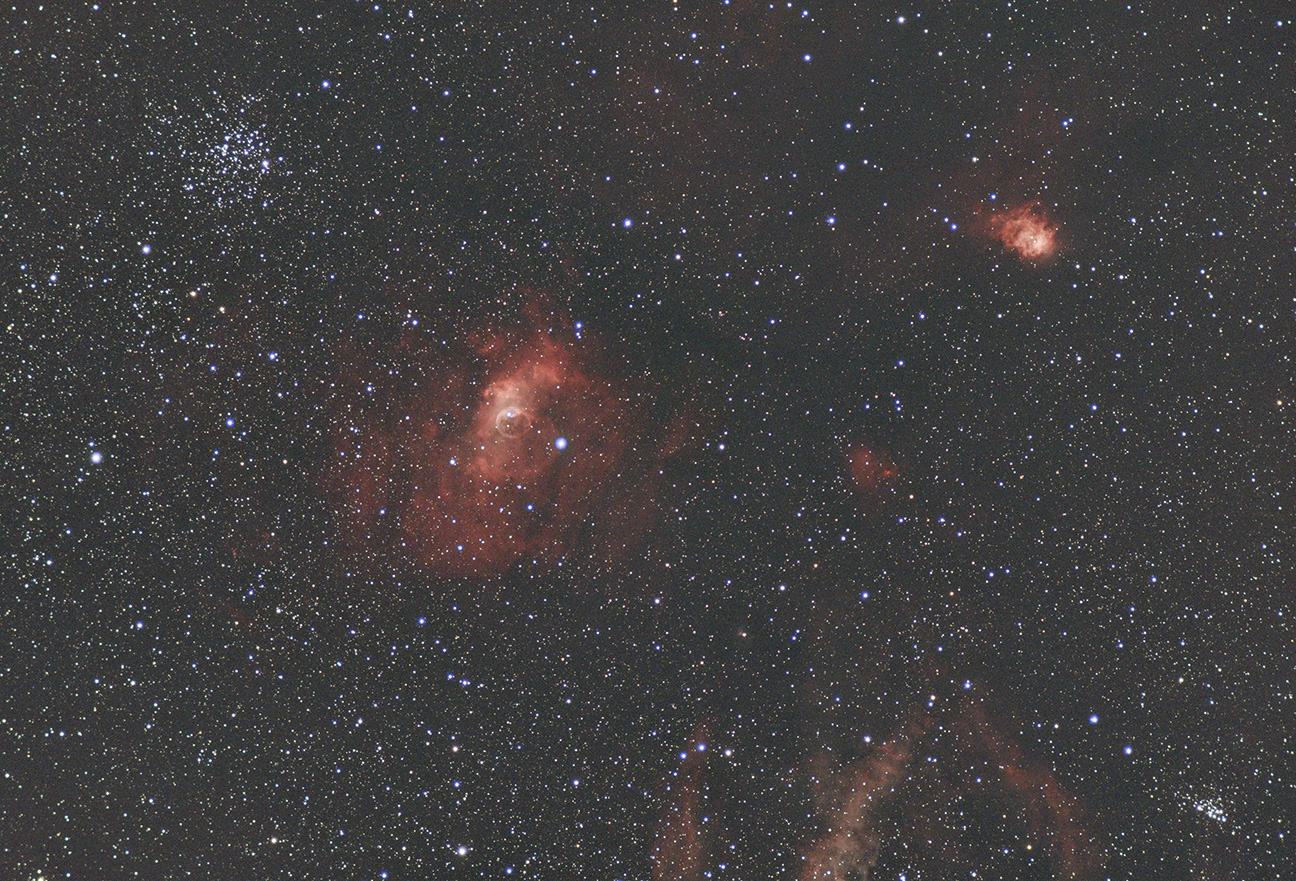
This is a narrowband and broadband image of the area around open cluster M52.
M52 is located at the upper left of the photo.
NGC7635 (Bubble Nebula) is just left of center.
Nebula NGC7538 is upper right.
Open cluster NGC7510 is lower right.
Coming up from the bottom center-right is the northern part of LBN 540 (The Lobster Claw Nebula?).
I can't find a designation for the small red nebula at right center.
This image was made from 29 x 2 minute exposures with the Optolong L-eNhance
narrow-band filter. I removed the stars with Starnet++.
Then I added 15 x 45s of unfiltered data to get the stars with better color.
The image was recorded from my suburban front yard using an ASI294mc-pro one-shot color camera.
I used my Genesis 4" f/5 telescope mounted on a iOptron GEM-45 equatorial mount.
An Orion 60mm finder/guider was used with an ASI120mm to guide.
The data was captured with APT. It was reduced, combined, and initially
processed with PixInsight.
Photoshop CC was used to combine the NB and BB data into the color image.
A weekend cold front brought clear skies and temperatures in the 50s for this capture.
For a larger view in a new window, click on the image.
Back to the top of the page
Back to Mark's Astrophotography Home
NGC 281 The Pacman Nebula - Sept. 4, 2020
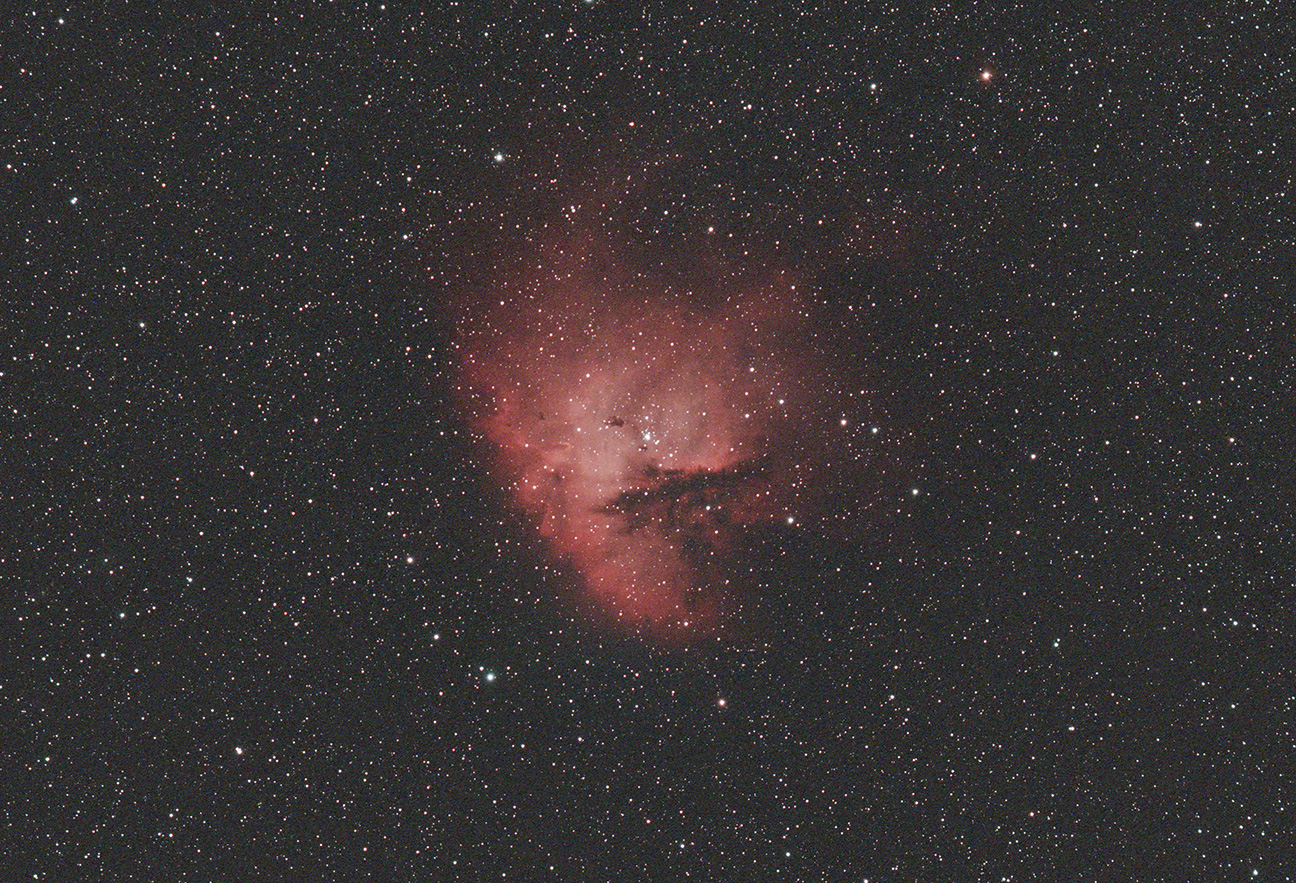
The Pacman nebula is a bright emission nebula in Cassiopeia.
This image is made up of 20 x 3 minute exposures taken through my Genesis 4" f/5
refractor.
I was using an ASI294mc-pro one-shot color camera with an attached
Optolong L-eNhance narrow-band filter from my front yard.
The telescope was mounted on a iOptron GEM-45.
An Orion 60mm finder/guider was used with an ASI120mm to guide.
The Moon was up and one day past full as this image was being taken.
It was very warm and humid with temps in the upper 70s.
The data was captured with APT. It was reduced, combined, and initially
processed with PixInsight, then final touches were made with Photoshop CC.
For a larger view in a new window, click on the image.
Back to the top of the page
Back to Mark's Astrophotography Home
NGC6888 Crescent Nebula - June 25, 2020
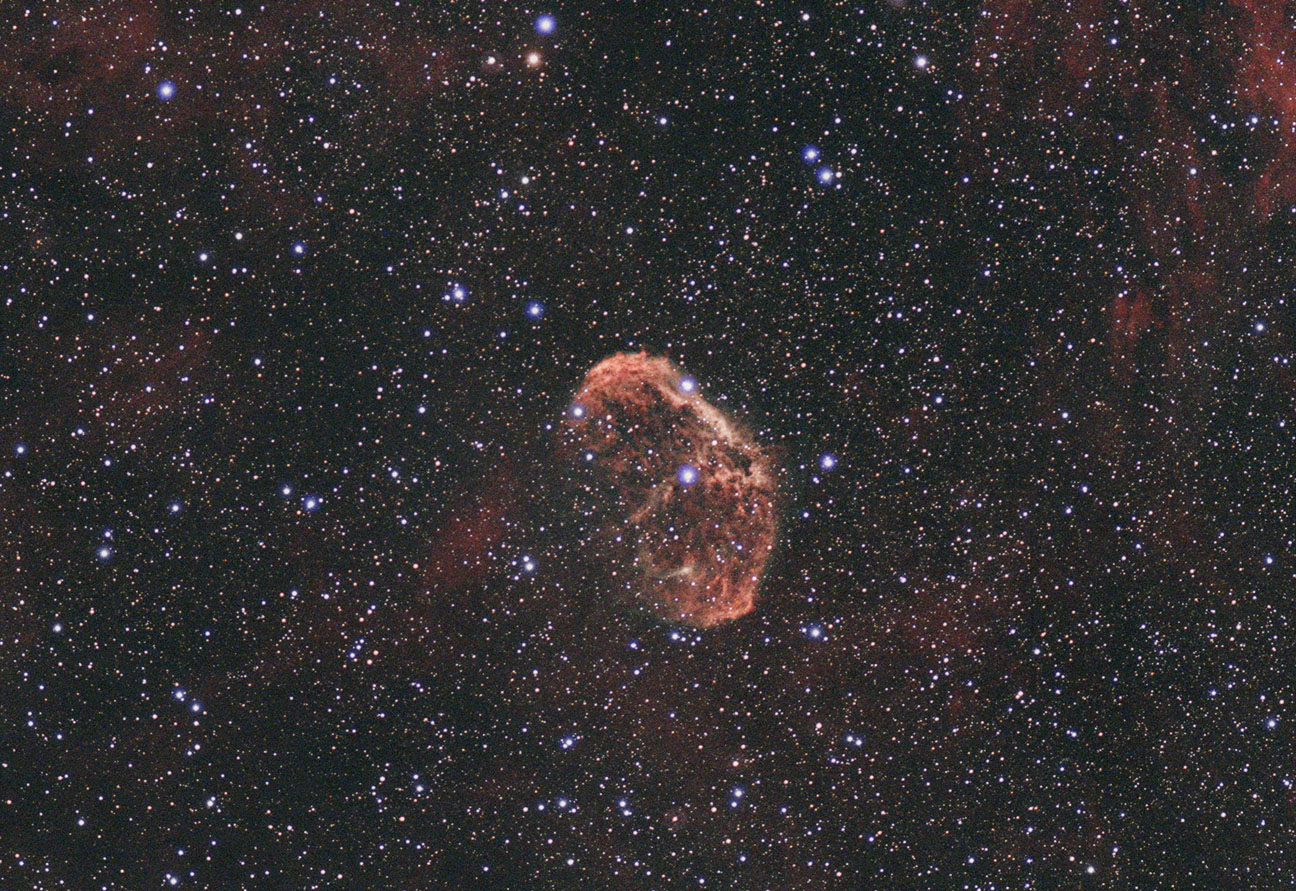
The Crescent Nebula - NGC 6888 in Cygnus taken in both broadband and narrowband.
This is my first attempt at any narrowband imaging.
The field of view is approximately 1 degree wide.
The image was captured from my front driveway in Cary, NC.
It was made from two sets of data taken one after the other.
First, I used an Optolong L-eNhance filter for 20 x 180s or 1 hour for the nebula.
Second, I captured the same field without filters for 20 x 30s for better star colors.
In PixInsight, the two sets of data were indepently calibrated, registered, combined,
and cropped to about 50% of the full size frame.
Then I took the narrowband image and removed all the stars with Starnet++.
In Photoshop using layers, I mixed the starless nebula with the short exposure stars.
Then did some levels, curves, and blue/violet halo reduction.
This version is much improved from the original version I posted here.
For image capture, I used APT and the following hardware:
ZWO ASI294mc-cool camera at unity gain,
TeleVue Genesis 4" f/5 refractor,
iOptron GEM-45 mount guided by my 60mm finder/guider and ASI120mm.
Click on the image for a larger view in a new window.
Back to the top of the page
Back to Mark's Astrophotography Home
M8 and M20 (Lagoon and Trifid Nebulae) in Sagittarius - Sept. 20, 2019
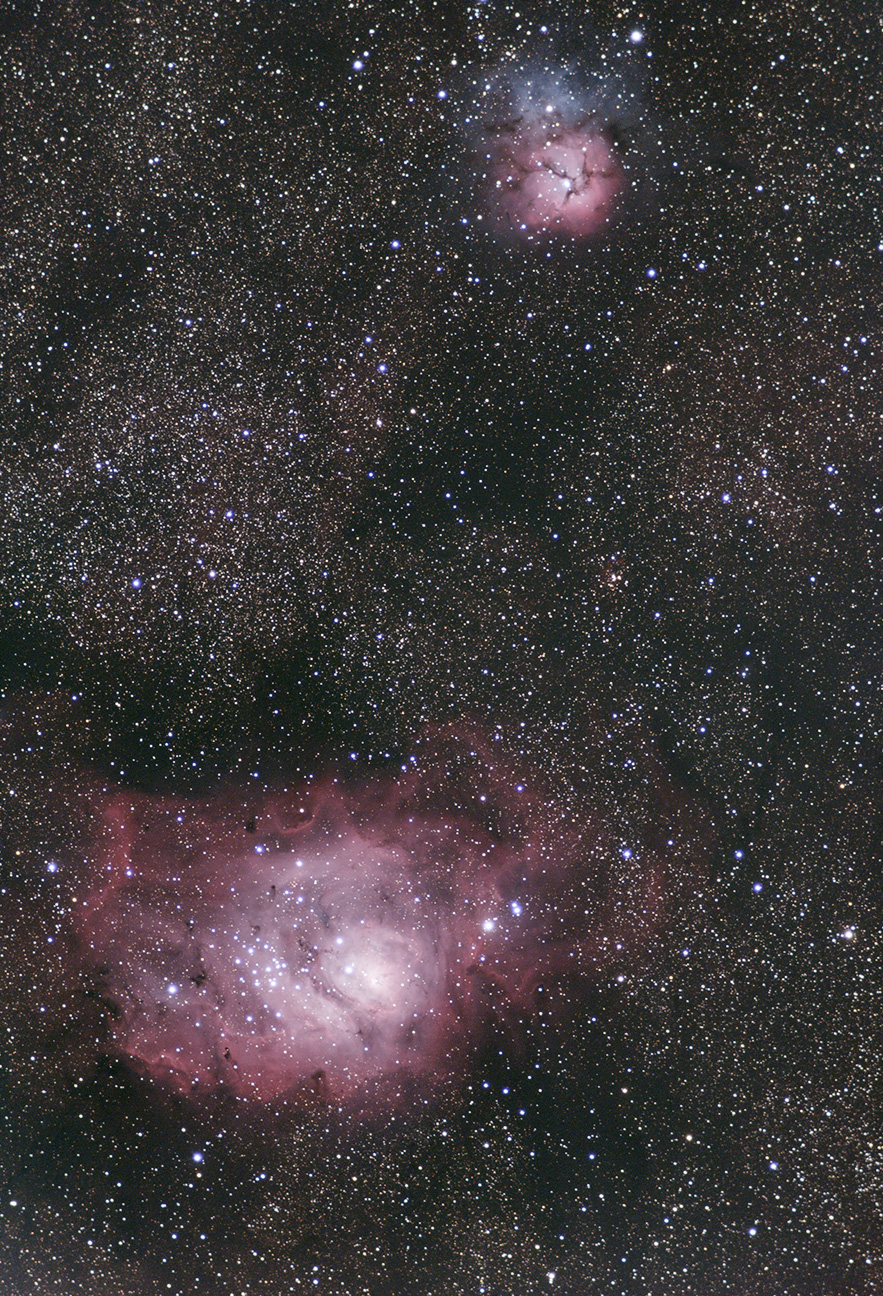
I finally got out to our BigWoods site to try out the ASI294 in darker skies than at my house.
After waiting for clouds to move out of the way, my objects were pretty low - 18 degrees
above the horizon.
Focus is a bit soft, but the photo turned out reasonably well despite the problems.
The image is the full frame of the ASI294 connected to my 4" f/5 TeleVue Genesis refractor.
18 x 60s subs were shot at unity gain and 0 degrees C.
I was using my Losmandy G-11 mount unguided.
APT was used for image aquisition then the subframes were processed with PixInsight.
Photoshop CC was used for a small contrast curve and then convert to jpg.
Click on the image for a larger view in a new window.
Back to the top of the page
Back to Mark's Astrophotography Home
Iris Nebula - Oct. 19, 2017
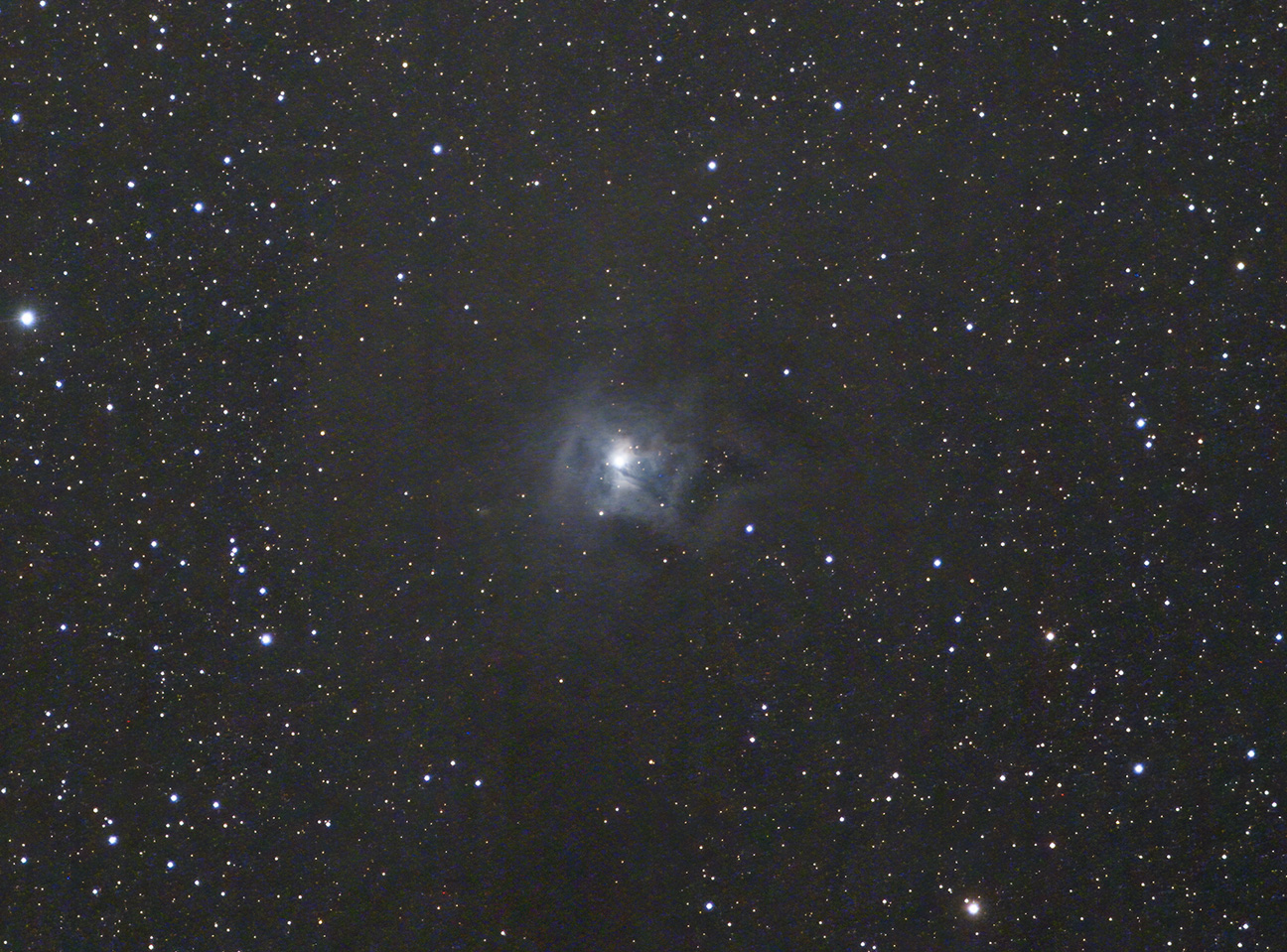
NGC 7023 - The Iris Nebula in Cepheus. The Iris Nebula is a bright reflection nebula
with dark dust surrounding it.
This image was taken at the Bigwoods site back in October.
This image is a combination of 30 x 1 minute exposures taken with my Canon XTi camera at
ISO 1600. I was using the 4" f/5 TeleVue Genesis refractor mounted on the Losmandy G-11.
Guiding was done with an Orion 60mm finder with an ATIK 16IC CCD camera.
The image data was re-processed in 2022 using PixInsight.
Click on the image for a larger view in a new window.
Back to the top of the page
Back to Mark's Astrophotography Home
The Rosette Nebula (NGC 2237) in Monoceros 12/25/2014
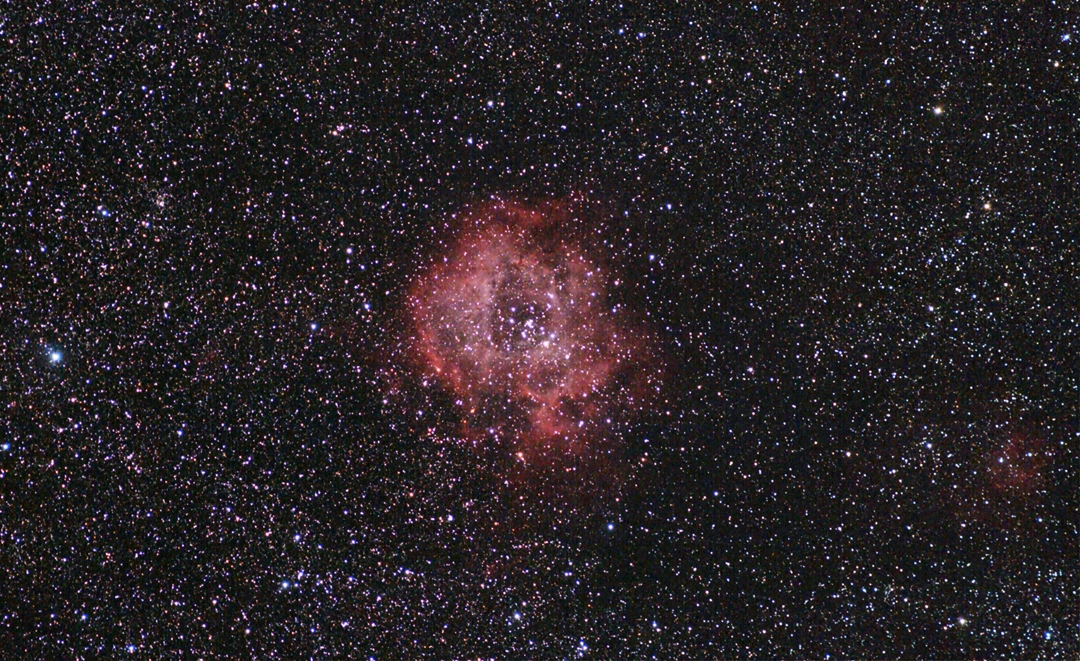
I took the photos of this object over a year ago, but gave up on processing them at the time.
I took up the processing task again in January 2016.
In the photo, north is to the left. The Rosette Nebula is centered with
the smaller nebula SH2-280 (aka LBN 970) near the right edge.
The photo was processed in ImagesPlus,
then it was taken to Photoshop for further processing such as star size reduction.
The version shown is slightly cropped from the original.
This widefield photo shows about 6 degrees of the sky left to right.
It was made from 30 x 25 second exposures @ ISO 1600.
I used my Canon XTi camera (modified) with a newly acquired but used Nikor 180mm f/2.8 lens attached.
Click on the image to see a larger version in a new window.
Back to Mark's Astrophotography Home
NGC 6625 area in Scutum/Serpens Cauda - August 14, 2015
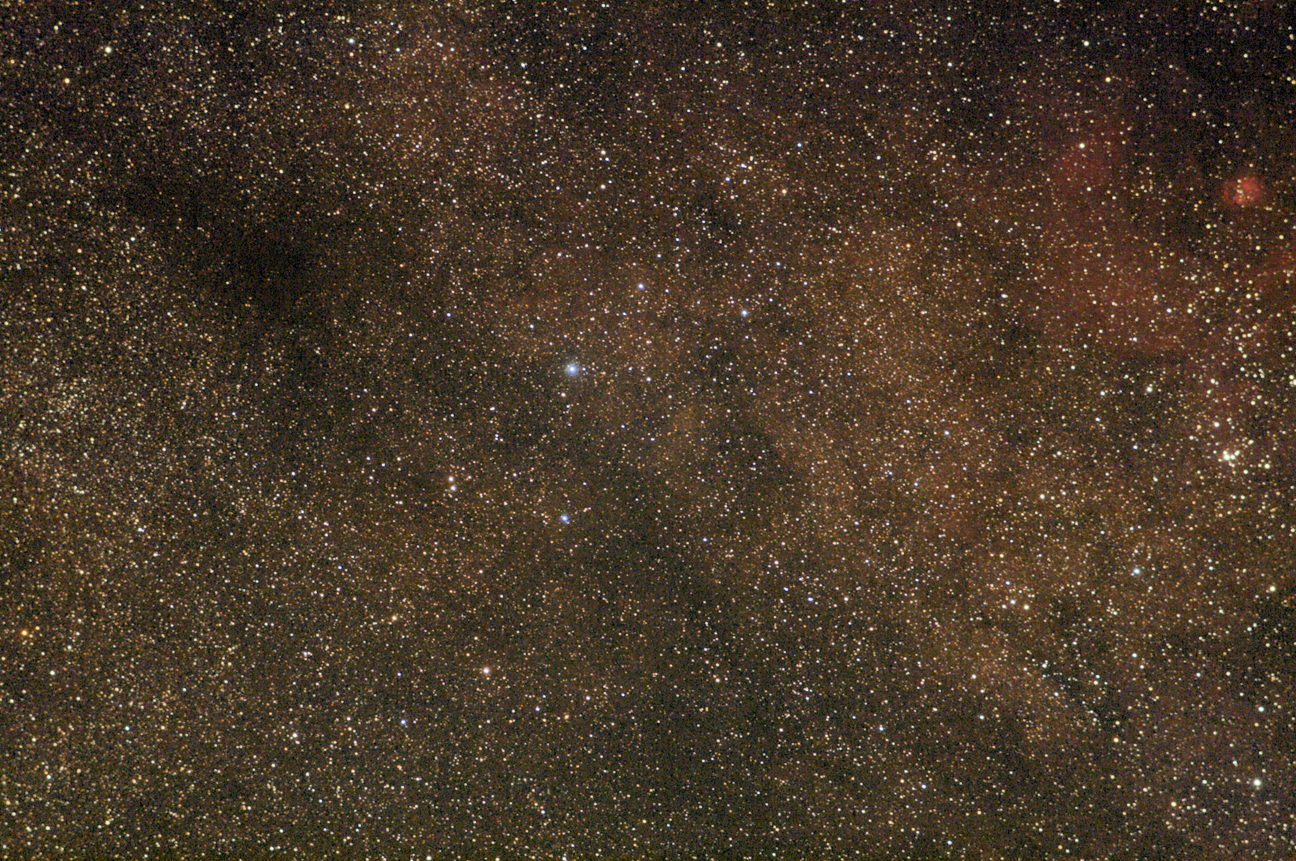
This photo was taken on August 14, 2015 at Bigwoods on RACOBS night.
I was trying to get three NGC open clusters in one shot.
It turned out that the clusters were not that interesting.
Fortunately, there were several other objects in the shot were interesting.
They were Lynds Dark Nebula LDN 406 at left,
Lynds Bright Nebula LBN 72 at right,
and intestellar matter in Minkowski's catalog Min 1-88.
Min 1-88 looks like a small version of the Trifid Nebula.
The shot was made with my Genesis refractor and my Canon Xti DSLR camera.
10 x 60 second subexposures were combined together to make the final image.
By moving the mouse pointer onto the image you will see the objects identified.
Click on the image to see a larger version in a new window.
Back to Mark's Astrophotography Home
Antares/M4/Rho Ophiuchus - Aug. 12, 2015
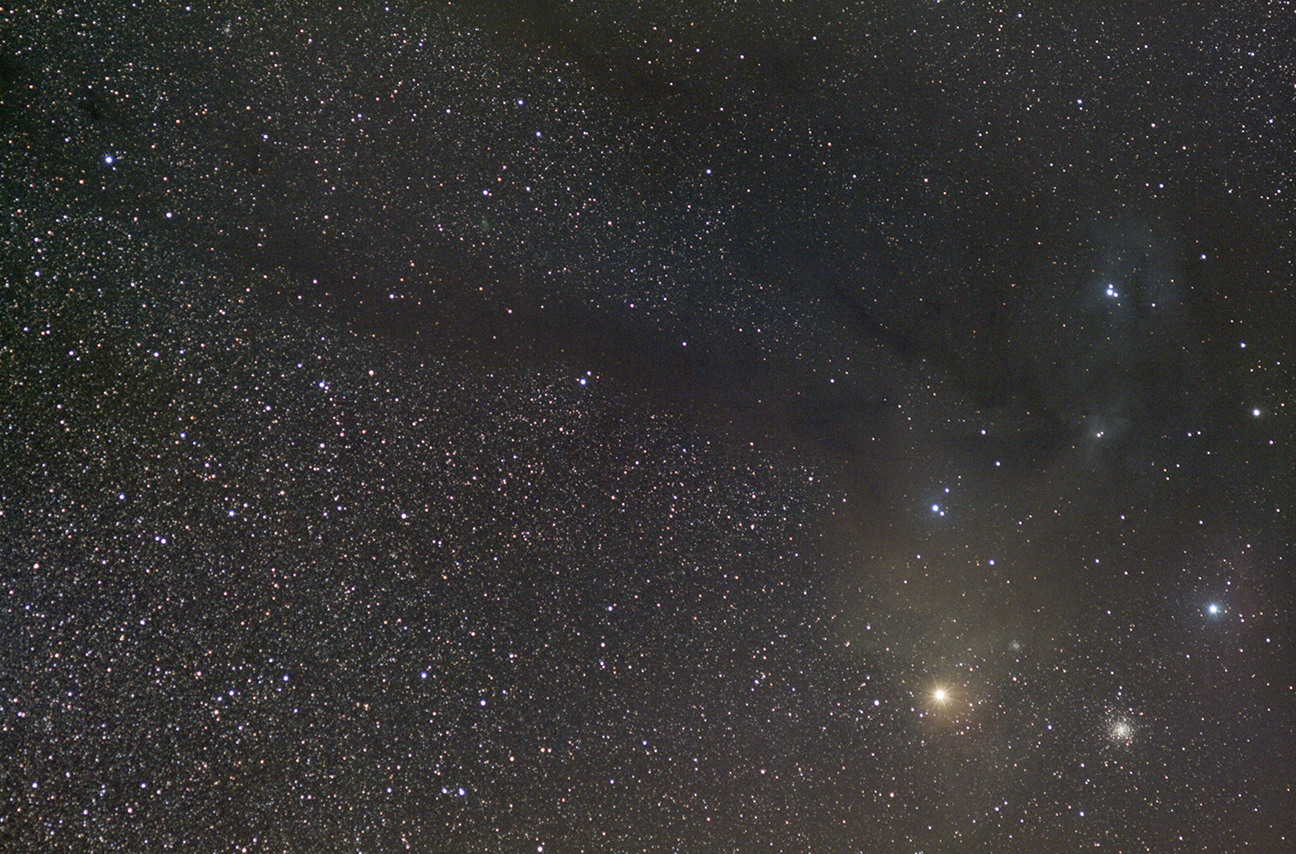
Streams of dark nebulosity eminate from the area between Antares (the bright yellow-orange star near bottom right)
and Rho Ophiuchus (the "Mickey Mouse" triple star) near the right center.
Also seen are globular clusters M4 (bottom right) and NGC 6144 (upper right of Antares).
There is red nebulosity around Sigma Scorpii (lower right), yellow nebulosity around Antares,
and blue nebulosity around Rho Ophiuchus.
This shot was taken the night of the Perseid Meteor shower at Stone Mountain, NC.
I was using my iOptron Sky tracker, my modified Canon XTi, and a Nikon 135mm lens.
Ten exposures of 90 seconds at ISO 800 were combined in ImagesPlus then taken to Photoshop CS2 for additional processing.
To see a larger view in a new window, click on the image.
Back to the top of the page
Back to Mark's Astrophotography Home
IC 5146 The Cocoon Nebula - Nov. 21, 2014
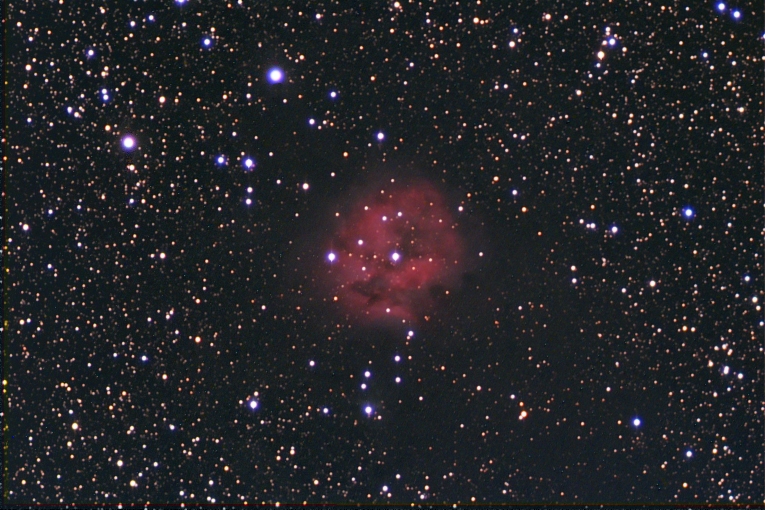
IC 5146, the Cocoon Nebula, is an emission nebula located in Cygnus. This image was taken on Nov. 21 at the Bigwoods site at Jordan Lake in central NC using my 4" Genesis refractor, and my SBIG ST-402 CCD camera mounted on my Losmandy G-11 mount. Guiding was done with a 60mm finderscope with an attached ATIK 16IC CCD camera. This LRGB image was made up of 5x3 minutes luminance, 15x2 minutes luminance, and 8x2 minutes each of RGB all binned 1x1. Images were captured, reduced, sigma combined, and bloom cleanup applied with MaximDL. Each color channel and luminance was output from MaximDL into Photoshop CS2 for color combination and additional processing. It was a cold clear night at Bigwoods with temperatures around 27 degrees F.
Back to the top of the pageBack to Mark's Astrophotography Home
North American and Pelican Nebulae - Oct. 23, 2014
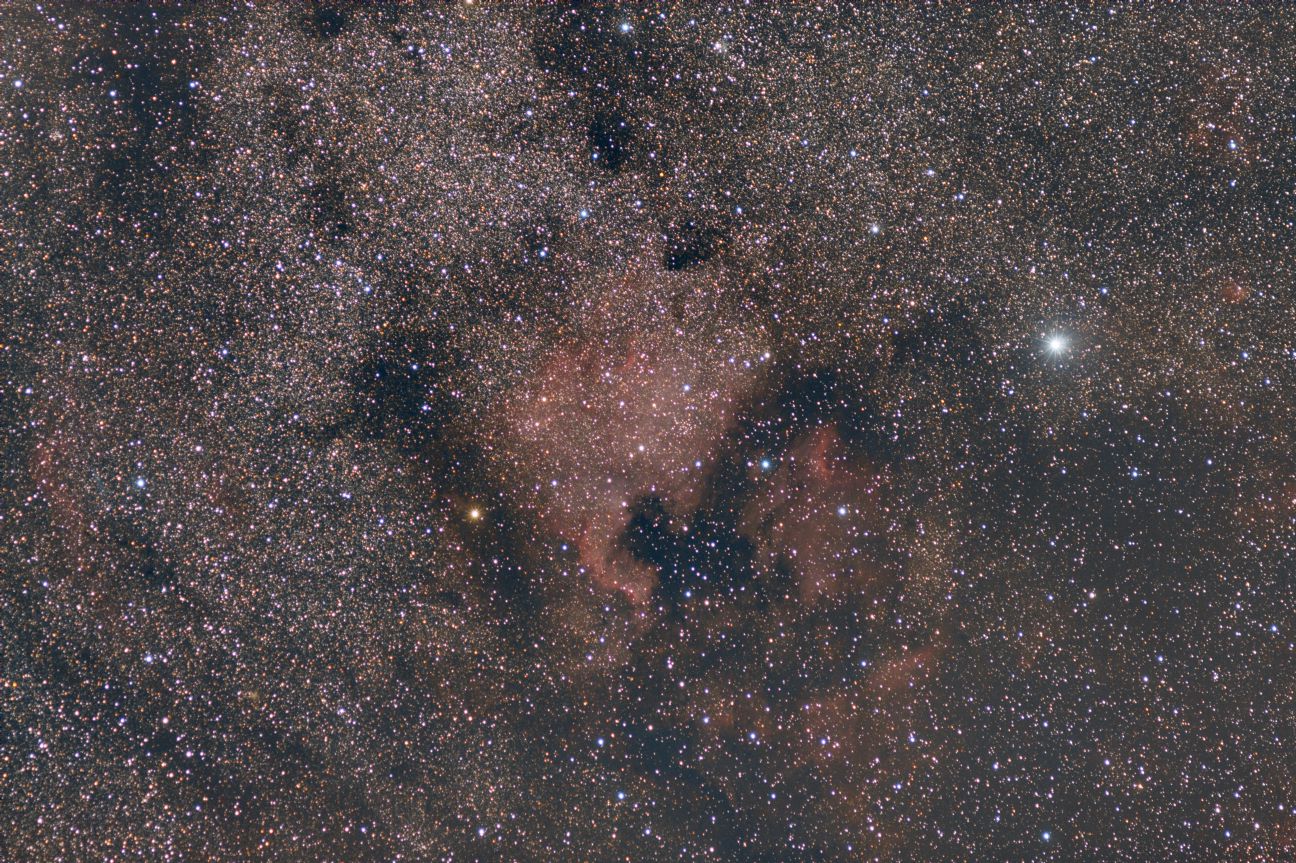
The North American Nebula and the Pelican Nebula taken from the Staunton River Star Party on
Oct. 23, 2014. This image was taken with my Canon XTi and a Nikkor 135mm lens working at f/4.
The shot was tracked but unguided. 26x2 minute exposures were combined together and
processed with PixInsight in 2022 for this result. The PI result looked better than the
initial ImagesPlus result from 2014. The shot is not cropped.
Click on the image for a larger view in a new window.
Back to Mark's Astrophotography Home
M17 - The Omega Nebulae in Sagittarius

M17 the Omega Nebula (also known as the Swan Nebula) in Sagittarius. Image captured at the Bigwoods site on Sept. 5, 2013. The photo was taken with the Genesis refractor and the Canon XTi. Twenty sixty second exposures at ISO 800 were combined in ImagesPlus.
Back to the top of the pageBack to Mark's Astrophotography Home
Veil Nebula

Caldwell 33 - The Eastern Veil Nebula. Nov. 24, 2006. This beautiful object is part the Eastern Veil Nebula in Cygnus. I intended to make a mosaic of the entire nebula, but the object got to low to finish the rest of the imaging. I ended up spending most of the evening working on the individual frames for this shot. This is a LRGB composite with a total exposure time of one hour. All the subframes (luminance, red, green, and blue) were 5 x 3 minutes each. Alignment and stacking of the individual channels was done with CCDSoft. Then the combined channels were brought into Photoshop CS2 for further processing, such as levels, curves, and color balance. North is to the right.
Back to the top of the pageBack to Mark's Astrophotography Home
Mosaic of the East and West Veil Nebulae in Cygnus - Oct. 28, 2016
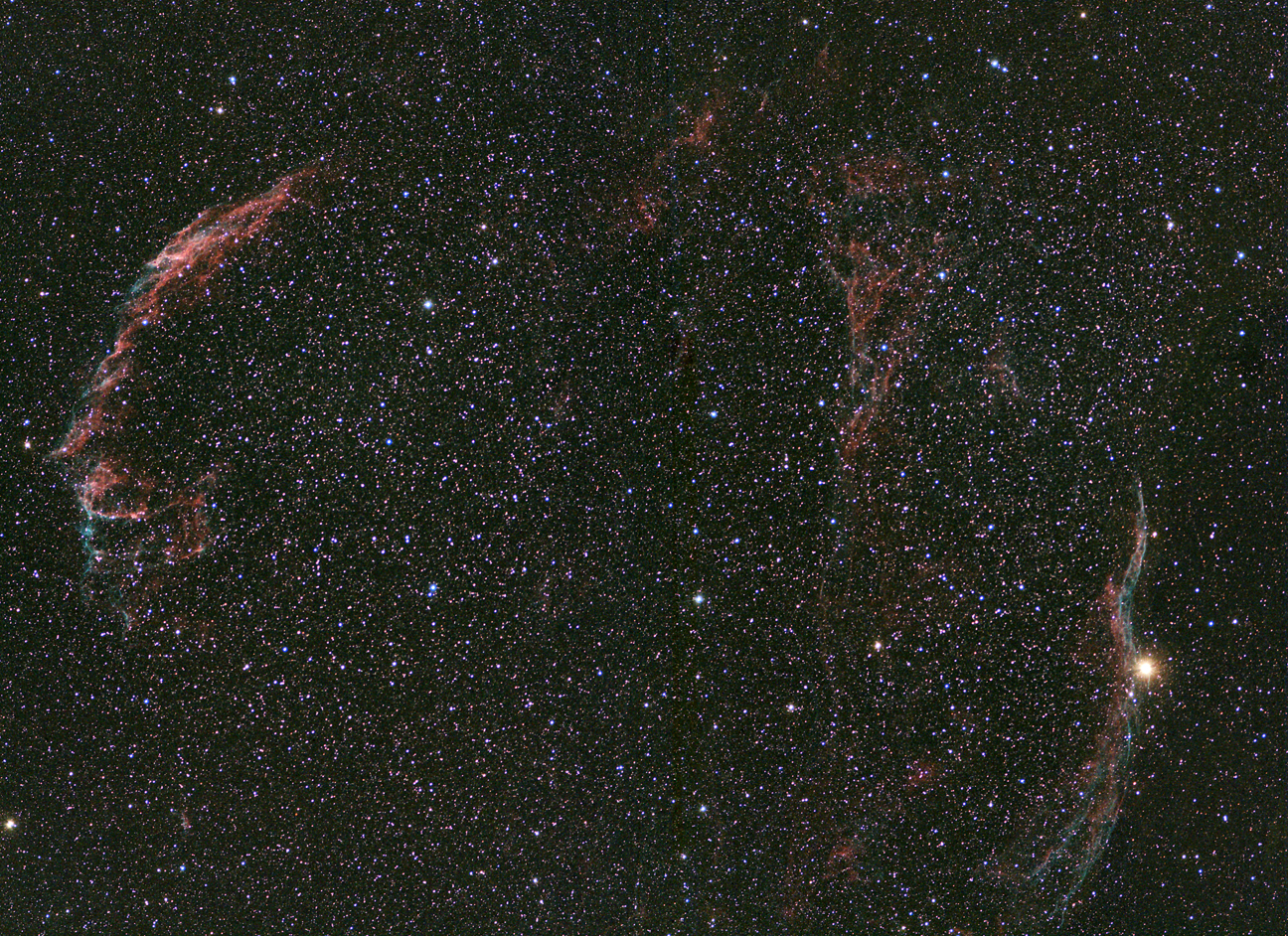
Mosaic of the East and West Veil Nebulae in Cygnus taken at the Bigwoods site at Jordan Lake, NC.
Click on the image above to see a 1/3 sized version of the original image in a new window.
This is my first try at a mosaic.
Is was a very tough challenge for me dealing with stitching the two images together
and dealing with the color gradients present in each individual image.
The mosaic was created from two almost identical shots of the area -
first the western side at 10 x 3 minutes
then the eastern side at 10 x 3 minutes.
North is at the top, east is left, and west is to the right.
I consider this image incomplete - there are still problems to fix - mostly with color issues
but I had to stop working on it for a while.
I was using my modded Canon XTi DSLR at ISO 1600.
The images were captured with Backyard EOS through my Genesis f/5 refractor which was
guided with MaximDL 5 through my Orion 60mm finder with an ATIK 16IC attached as a guide camera.
The Losmandy G-11 was the mount used.
The images were combined and initially stretched with ImagesPlus,
and much final adjustment was made with Photoshop CS2.
Back to Mark's Astrophotography Home
Sadr, IC 1318, NGC 6910 in Cygnus - Oct. 23, 2016
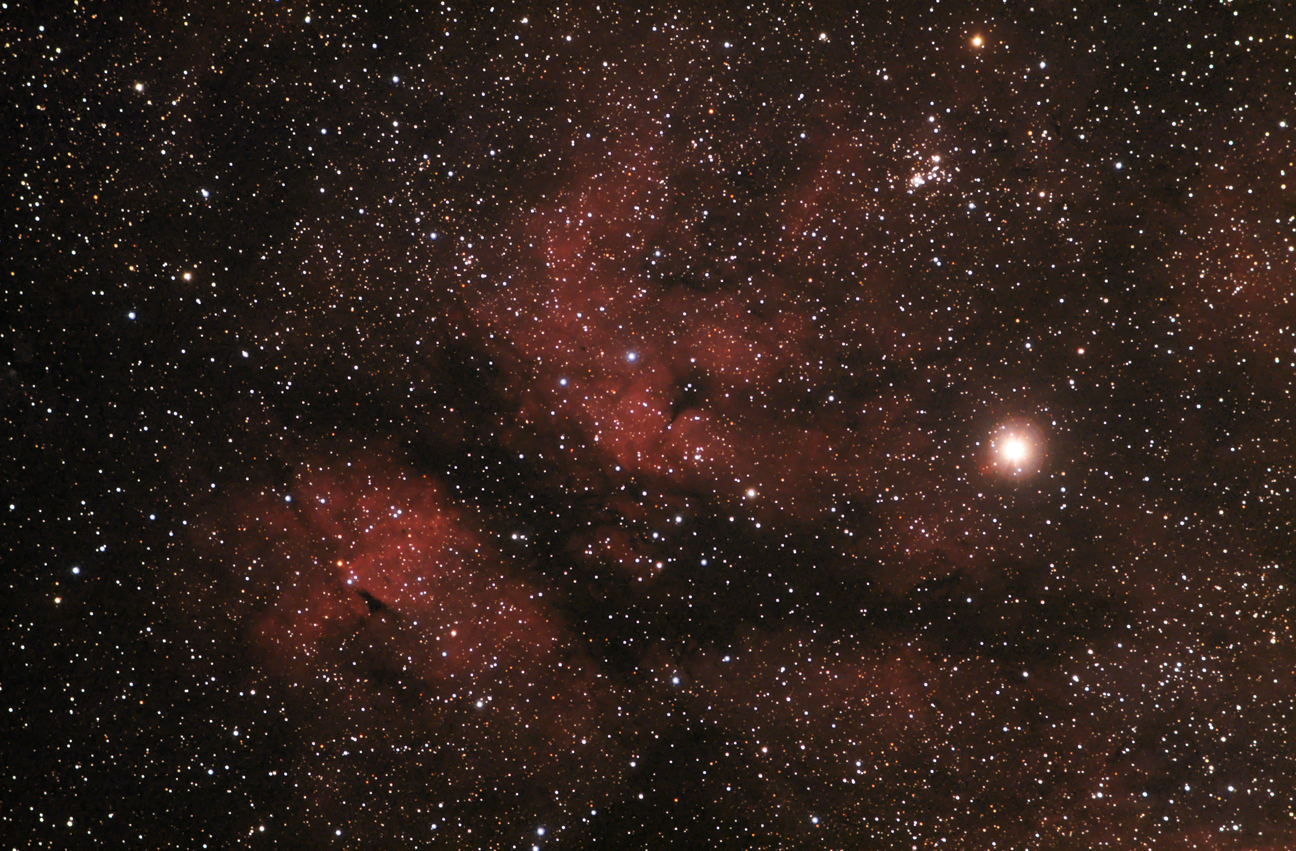
Sadr (Gamma Cygni) area.
The very bright star is Sadr, NGC 6910 is the small open cluster upper left of Sadr,
and IC 1318 (Butterfly Nebula) is the red nebulosity left of Sadr.
This photo was taken at our Bigwoods site under clear cool October skies.
20 x 90 second unguided shots at ISO 800 were taken with Backyard EOS.
They were combined and stretched using ImagesPlus and then taken to Photoshop CS2 for final processing.
I used my Televue Genesis 4" f/5 refractor, an old Canon XTi, and my Losmandy G-11 mount.
Click on the image for a larger view in a new window.
Back to Mark's Astrophotography Home